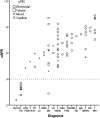Proteinuria-take a closer look!
- PMID: 31925536
- PMCID: PMC7056687
- DOI: 10.1007/s00467-019-04454-w
Proteinuria-take a closer look!
Abstract
Proteinuria is a hallmark of kidney disease. Therefore, measurement of urine protein content plays a central role in any diagnostic work-up for kidney disease. In many cases, proteinuria analysis is restricted to the measurement of total protein content knowing that very high levels of proteinuria (nephrotic proteinuria) are characteristic of glomerular disease. Still, proteinuria can also be a manifestation of impaired tubular protein reabsorption or even be physiological. This review will discuss the physiology of renal protein handling and give guidance on a more sophisticated analysis of proteinuria differentiating albumin, low-molecular weight proteins and immunoglobulins. These non-invasive tests are available in most routine clinical laboratories and may guide the clinician in the diagnostic process before ordering far more expensive (molecular genetic testing) and/or invasive (kidney biopsy) diagnostics.
Keywords: Acute kidney injury; Glomerular disease; Low molecular weight proteins; Proteinuria; Selectivity; Tubulointerstitial disease.
Conflict of interest statement
The author declares that there is no conflict of interest.
Figures





Similar articles
-
Normal and abnormal aspects of proteinuria. Part I: Mechanisms, characteristics and analyses of urinary protein. Part II: Clinical considerations.Exp Pathol. 1986;29(1):1-28. doi: 10.1016/s0232-1513(86)80002-0. Exp Pathol. 1986. PMID: 2422051 Review.
-
Diagnostic significance of SDS-PAA-electrophoresis of urinary proteins: different forms of proteinuria and their correlation to renal diseases.Curr Probl Clin Biochem. 1979;(9):235-48. Curr Probl Clin Biochem. 1979. PMID: 446075
-
Simultaneous measurement of urinary albumin and total protein may facilitate decision-making in HIV-infected patients with proteinuria.HIV Med. 2012 Oct;13(9):526-32. doi: 10.1111/j.1468-1293.2012.01003.x. Epub 2012 Mar 14. HIV Med. 2012. PMID: 22413854
-
Proteinuria: detection and role in native renal disease progression.Transplant Rev (Orlando). 2012 Jan;26(1):3-13. doi: 10.1016/j.trre.2011.10.002. Transplant Rev (Orlando). 2012. PMID: 22137726 Review.
-
[Assessment of proteinuria].Praxis (Bern 1994). 2013 Jun 19;102(13):797-802. doi: 10.1024/1661-8157/a001340. Praxis (Bern 1994). 2013. PMID: 23773939 Review. German.
Cited by
-
Increased Renal Medullary NOX-4 in Female but Not Male Mice during the Early Phase of Type 1 Diabetes: Potential Role of ROS in Upregulation of TGF-β1 and Fibronectin in Collecting Duct Cells.Antioxidants (Basel). 2023 Mar 16;12(3):729. doi: 10.3390/antiox12030729. Antioxidants (Basel). 2023. PMID: 36978977 Free PMC article.
-
Usefulness of A Random Spot Urine Proteins-to-Creatinine Ratio to Screen for Increased Albuminuria in Patients with Type 1 Diabetes.Rep Biochem Mol Biol. 2025 Jan;13(4):561-569. doi: 10.61186/rbmb.13.4.561. Rep Biochem Mol Biol. 2025. PMID: 40842900 Free PMC article.
-
Prevalence of chronic kidney disease among young people living with HIV in Sub Saharan Africa: A systematic review and meta-analysis.PLoS One. 2024 Nov 4;19(11):e0301954. doi: 10.1371/journal.pone.0301954. eCollection 2024. PLoS One. 2024. PMID: 39495780 Free PMC article.
-
Obesity-Related Kidney Disease in Bariatric Surgery Candidates.Obes Surg. 2025 Jan;35(1):181-188. doi: 10.1007/s11695-024-07602-w. Epub 2024 Dec 5. Obes Surg. 2025. PMID: 39636519 Free PMC article.
-
Renal Dysfunction Phenotypes in Patients Undergoing Obesity Surgery.Biomolecules. 2023 May 3;13(5):790. doi: 10.3390/biom13050790. Biomolecules. 2023. PMID: 37238660 Free PMC article.
References
-
- KDIGO (2013) Clinical practice guideline for the evaluation and management of chronic kidney disease. Kidney Int Suppl:1–150
-
- Beara-Lasic L, Cogal A, Mara K, Enders F, Mehta RA, Haskic Z, Furth SL, Trachtman H, Scheinman SJ, Milliner DS, Goldfarb DS, Harris PC, Lieske JC, investigators of the Rare Kidney Stone Consortium (2019) Prevalence of low molecular weight proteinuria and Dent disease 1 CLCN5 mutations in proteinuric cohorts. Pediatr Nephrol. 10.1007/s00467-019-04210-0 - PMC - PubMed
-
- Inker LA, Grams ME, Levey AS, Coresh J, Cirillo M, Collins JF, Gansevoort RT, Gutierrez OM, Hamano T, Heine GH, Ishikawa S, Jee SH, Kronenberg F, Landray MJ, Miura K, Nadkarni GN, Peralta CA, Rothenbacher D, Schaeffner E, Sedaghat S, Shlipak MG, Zhang LX, van Zuilen AD, Hallan SI, Kovesdy CP, Woodward M, Levin A, CKD Prognosis Consortium Relationship of estimated GFR and albuminuria to concurrent laboratory abnormalities: an individual participant data meta-analysis in a global consortium. Am J Kidney Dis. 2019;73:206–217. - PMC - PubMed
-
- Heerspink HJL, Greene T, Tighiouart H, Gansevoort RT, Coresh J, Simon AL, Chan TM, Hou FF, Lewis JB, Locatelli F, Praga M, Schena FP, Levey AS, Inker LA, Chronic Kidney Disease Epidemiology Collaboration Change in albuminuria as a surrogate endpoint for progression of kidney disease: a meta-analysis of treatment effects in randomised clinical trials. Lancet Diabetes Endocrinol. 2019;7:128–139. - PubMed
Publication types
MeSH terms
LinkOut - more resources
Full Text Sources
Medical

